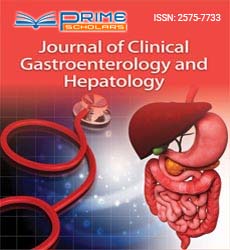Short Communication - (2023) Volume 7, Issue 5
Gastric Cancer: Understanding the Silent Threat to Digestive Health
Alexander Benjamin*
Department of Gastroenterology, University of Copenhagen, Denmark
*Correspondence:
Alexander Benjamin,
Department of Gastroenterology, University of Copenhagen,
Denmark,
Email:
Received: 02-Oct-2023, Manuscript No. IPJCGH-23-18372;
Editor assigned: 04-Oct-2023, Pre QC No. IPJCGH-23-18372 (PQ);
Reviewed: 18-Oct-2023, QC No. IPJCGH-23-18372;
Revised: 23-Oct-2023, Manuscript No. IPJCGH-23-18372 (R);
Published:
30-Oct-2023, DOI: 10.36648/2575-7733.7.5.42
Introduction
Gastric cancer, also known as stomach cancer, is a formidable adversary that silently affects the digestive system. It ranks among the most common cancers globally and poses a significant health challenge. In this article, we explore the causes, risk factors, symptoms, and treatment options associated with gastric cancer. Gastric cancer often begins in the lining of the stomach and may develop slowly over many years. The exact cause is not always clear, but several factors contribute to its development. Chronic infection with Helicobacter pylori, a bacterium that can infect the stomach lining, is a major risk factor for gastric cancer. This infection can lead to chronic inflammation, increasing the likelihood of cancerous changes [1,2].
Description
Gastric cancer is more common in older adults, with the risk increasing significantly after the age of 50. Additionally, men are more likely to develop gastric cancer than women. Diets high in salty and smoked foods, as well as low in fruits and vegetables, have been linked to an increased risk of gastric cancer. Nitrites and nitrates found in processed meats may also contribute to the risk. A family history of gastric cancer or certain genetic conditions, such as hereditary diffuse gastric cancer and Lynch syndrome, can elevate an individual’s risk. Both smoking and excessive alcohol consumption are associated with an increased risk of gastric cancer. These lifestyle factors can contribute to chronic inflammation and damage to the stomach lining. Gastric cancer is often referred to as a silent disease because it may not cause noticeable symptoms in its early stages. As the cancer advances, however, symptoms may include. A sudden loss of appetite and a feeling of fullness even after a small meal can be associated with gastric cancer. Early diagnosis is crucial for effective treatment. The diagnosis of gastric cancer involves a combination of medical history analysis, physical examinations, imaging studies such as CT scans and endoscopy, and laboratory tests. A biopsy, where a small
tissue sample is taken from the stomach lining, is often necessary to confirm the presence of cancer cells. Staging is a critical aspect of determining the extent of gastric cancer and guiding treatment decisions. The TNM staging system, which considers the size of the tumor, lymph node involvement, and the presence of metastasis, helps classify gastric cancer into different stages. Surgical removal of the tumor and surrounding tissues is a common approach, especially in the early stages of gastric cancer. Chemotherapy involves the use of drugs to kill or slow the growth of cancer cells [3,4].
Conclusion
It may be administered before surgery neo adjuvant chemotherapy or after surgery adjuvant chemotherapy. High-energy rays are used to target and destroy cancer cells. Radiation therapy may be used before surgery to shrink the tumor or after surgery to eliminate remaining cancer cells. Targeted drugs focus on specific molecules involved in cancer growth and progression. They are often used in combination with chemotherapy. Immunotherapy boosts the body’s immune system to fight cancer cells. It is being investigated as a treatment option for gastric cancer. The prognosis for gastric cancer varies based on the stage at diagnosis and the effectiveness of treatment. Prevention strategies include. Treating and eliminating infections can reduce the risk of developing gastric cancer.
Acknowledgement
None.
Conflict Of Interest
The authors declare that they have no conflict of interest.
References
- Correa P (2013) Gastric Cancer: Overview. Gastroenterol Clin North Am. 42(2):211-7.
[Crossref] [Google Scholar] [PubMed]
- Chia NY, Tan P (2022) Molecular classification of gastric cancer. Ann Oncol. 27(5):763-9.
[Crossref] [Google Scholar] [PubMed]
- Ang TL, Fock KM (2014) Clinical epidemiology of gastric cancer. Singapore Med J. 55(12):621-8.
[Crossref] [Google Scholar] [PubMed]
- Puliga E, Corso S, Pietrantonio F, Giordano S (2021) Microsatellite instability in Gastric Cancer: Between lights and shadows. Cancer Treat Rev. 95:102175.
[Crossref] [Google Scholar] [PubMed]
Citation: Benjamin A (2023) Gastric Cancer: Understanding the Silent Threat to Digestive Health. J Clin Gastroenterology Hepatol.
7:42.
Copyright: © 2023 Benjamin A. This is an open-access article distributed under the terms of the Creative Commons Attribution License, which permits unrestricted use, distribution, and reproduction in any medium, provided the original author and source are credited.

